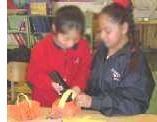| • |
Draw pictures of family members as they
relate to characters in book, e.g. traveling in a foreign
country, participating in some sport or activity, groomed or
dressed in some culture-specific way, etc. |
| • |
Make finger puppets of the book's
characters and re-enact a part of the story. |
| • |
Make a mask of an animal, celebrity,
or fantasy creature that relates to the story. |
| • |
Make a headband featuring pictures or
words from the story. |
| • |
Make flashcards with characters from
the story on them (include character names). |
| • |
Make a puzzle for the book; draw a
picture on a piece of paper, then cut zig zag pieces, mix
pieces up and assemble the puzzle. |
| • |
Write a letter of thanks to a parent,
teacher, or friend for something that relates to a story
element. |
| • |
Create a bookmark with drawings and
an inspirational, motivational, or generally poignant excerpt
from the book. |
| • |
Make a picture frame featuring elements
from the story for a particular photo the student may have at
home. |
| • |
Draw a poster featuring a scene from
the book and an appropriate message. |
| • |
Build a mobile with origami or cutout
figures representing characters or objects from the story. |
| • |
Make a paper chain that relates
to the book. |
| • |
Weave baskets from strips of paper, and
decorate relevant to a theme in the book. |
| • |
 Use an assembly-line approach for
constructing an item like a snowman or a totem pole or a paper
quilt. Each student creates several copies of a specific
component of the final item. For example, with a group of
six kids building six snowmen, have one student create six heads,
another create six torsos, another create twelve arms, another
create six hats, etc. In the end, create an assembly line and
have each student add his or her component until each item
is complete.
Use an assembly-line approach for
constructing an item like a snowman or a totem pole or a paper
quilt. Each student creates several copies of a specific
component of the final item. For example, with a group of
six kids building six snowmen, have one student create six heads,
another create six torsos, another create twelve arms, another
create six hats, etc. In the end, create an assembly line and
have each student add his or her component until each item
is complete. |
| • |
Create a recipe sheet describing a
favorite dish and one's idea of how it is prepared. |